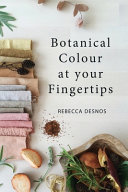

Most ebook files are in PDF format, so you can easily read them using various software such as Foxit Reader or directly on the Google Chrome browser.
Some ebook files are released by publishers in other formats such as .awz, .mobi, .epub, .fb2, etc. You may need to install specific software to read these formats on mobile/PC, such as Calibre.
Please read the tutorial at this link: https://ebookbell.com/faq
We offer FREE conversion to the popular formats you request; however, this may take some time. Therefore, right after payment, please email us, and we will try to provide the service as quickly as possible.
For some exceptional file formats or broken links (if any), please refrain from opening any disputes. Instead, email us first, and we will try to assist within a maximum of 6 hours.
EbookBell Team

0.0
0 reviewsThis eBook will show you how to extract dye from wild plants, garden herbs, kitchen waste, as well as fruit and vegetables that you can buy from the supermarket. Dye your own fabric, yarn and clothing whilst using soya milk to bind the colours. There is colour potential all around us just waiting to be unlocked!
In this 40+ page eBook, I share my own methods with you, step-by-step. The pages are bursting with photos of the dyeing process as well as photos of fabric and yarn samples from lots of different plants.
Perhaps you already dye with plants using conventional mordants such as alum and would like to try the more natural soya milk method for fixing colours? Maybe you are beginning your journey with plant dyeing now? Either way, there is something for you in my book.
THE EBOOK COVERS THE FOLLOWING + MUCH MOREThis book focuses on dyeing cellulose fibres, such as linen, cotton, hemp and bamboo viscose/rayon. I am vegan and do not use any animal protein fibres like wool or silk. Of course my dyeing methods can be applied to animal fibres, if you choose.